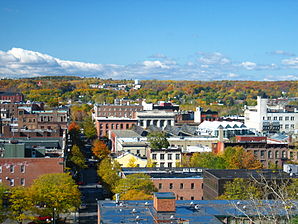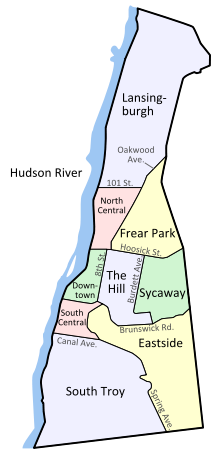Troy (New York)
| Troy | ||
|---|---|---|
| Nickname : The Collar City | ||
 Downtown |
||
 seal |
||
| Location in New York | ||
|
|
||
| Basic data | ||
| Foundation : | 1787 | |
| State : | United States | |
| State : | new York | |
| County : | Rensselaer County | |
| Coordinates : | 42 ° 44 ′ N , 73 ° 41 ′ W | |
| Time zone : | Eastern ( UTC − 5 / −4 ) | |
|
Inhabitants : - Metropolitan Area : |
50,129 (status: 2010) 850,957 (status: 2006) |
|
| Population density : | 1,870.5 inhabitants per km 2 | |
| Area : | 28.6 km 2 (approx. 11 mi 2 ) of which 26.8 km 2 (approx. 10 mi 2 ) are land |
|
| Height : | 75 m | |
| Postcodes : | 12179-12182 | |
| Area code : | +1 518 | |
| FIPS : | 36-75484 | |
| GNIS ID : | 979559 | |
| Website : | www.troyny.gov | |
Troy is a city in the US state of New York in the United States . In the city is the seat of the county seat of Rensselaer County . The city's motto is Ilium fuit, Troy est , which means Troy was, Troy is .
Troy is on the east bank of the Hudson River . The nearby cities of Schenectady and Albany together with Troy form the so-called Capital District .
The city received the name "Collar City" because of the textile production - including shirts, collars and ribbons (English collars). The steel industry also played an important role in the city - at times the city was the second largest production location in the USA after Pittsburgh .
history
Before the arrival of the Europeans, the area of today's city was inhabited by the Mahican Indians. The Dutch settled here from the 17th century. Troy received its current name in 1789. In 1816 the settlement was declared a city.
In 1823 the world-famous poem The Night Before Christmas was published for the first time in Troy . In 1824, Stephen Van Rensselaer founded the Rensselaer School , today's Rensselaer Polytechnic Institute (RPI), which is considered the oldest technical university in the English-speaking world. In 1862 the worst fire in the history of the city raged, caused by flying sparks from a locomotive.
During the 19th and early 20th centuries, Troy was one of the wealthiest cities in New York State, if not the whole of the United States. Originally, the city was primarily a trading center for meat and vegetables from Vermont , which came to New York City on the Hudson River . Shipping played an even more important role when the Erie Canal opened in 1825 .
Troy's great wealth came from the steel industry, as the first Bessemer pear in the USA was located in Wynantskill, southeast of the city . At first both the iron ore and the charcoal used for smelting it came from the Adirondacks , later ore and coal from the Midwest were brought to Troy on the Erie Canal. The steel produced was transported on the Hudson River to New York City, some was also processed by the state arms factory on the opposite bank in Watervliet , then called West Troy. The sufficiently available steel also led to its first uses as a building material, both for shop facades and as a structural element in house construction. Examples from this period are still available today.
After the Civil War , the steel industry moved further west, where it could produce closer to the raw materials, making way for a broad spectrum of mechanical industry and scientific instrument making, the prosperity of which was supported by the Rensselaer Polytechnic Institute present. Troy was the seat of Gurley Precision Instruments (GPI), manufacturer of measuring instruments for the paper industry, theodolites and rotary encoders , and the bell factory Meneely Bell Foundry .
geography
According to the United States Census Bureau , the city has a total area of 28.6 km², of which 26.8 km² is land and 1.8 km² (= 6.72%) is water.
Troy is a few miles north of Albany on the other side of the Hudson River , not far from where the Erie Canal and Champlain Canals split, at the end of the New York Barge Canal .
The city forms the central section of the western border of Rensselaer County. The Hudson River forms the western limit of the urban area and is also the border between Rensselaer County and Albany County. Neighboring to the north is the Town of Schaghticoke , Brunswick is adjacent to the east, and North Greenbush is to the south; to the west is on the other side of the river in Albany County, the Colonie with the Villages of Menands and Green Island and the Citys of Watervliet and Cohoes . In the northwest Troy is also adjacent to the inside of the Town of Waterford in Saratoga County location Village of Waterford .
The western edge of the city is the flat bank area on the Hudson River. The profile then rises steeply towards the eastern parts of Troy. Troy is on average about 15 m high, but the terrain to the east is about 150 m high. The urban area is an elongated area that is wider in the south than in the north, which is formed by Lansingburgh, which was independent until 1900 . Several kills flow through Troy and empty into the Hudson River, Poesten Kill and Wynants Kill are the two largest of them, in the course of which there are numerous small lakes and waterfalls. Other lakes and reservoirs in the metropolitan area include Ida Lake, Burden Pond, Lansingburgh Reservoir, Bradley Lake, Smarts Pond, and Wright Lake.
Demographics
| Population development | |||
|---|---|---|---|
| Census | Residents | ± in% | |
| 1800 | 4926 | - | |
| 1810 | 3895 | -20.9% | |
| 1820 | 5264 | 35.1% | |
| 1830 | 11,556 | 119.5% | |
| 1840 | 19,334 | 67.3% | |
| 1850 | 28,785 | 48.9% | |
| 1860 | 39,235 | 36.3% | |
| 1870 | 46,465 | 18.4% | |
| 1880 | 56,747 | 22.1% | |
| 1890 | 60,956 | 7.4% | |
| 1900 | 69,651 | 14.3% | |
| 1910 | 76,813 | 10.3% | |
| 1920 | 71,996 | -6.3% | |
| 1930 | 72,763 | 1.1% | |
| 1940 | 70,304 | -3.4% | |
| 1950 | 72,311 | 2.9% | |
| 1960 | 67,129 | -7.2% | |
| 1970 | 62,918 | -6.3% | |
| 1980 | 56,638 | -10% | |
| 1990 | 54,269 | -4.2% | |
| 2000 | 49,170 | -9.4% | |
| 2010 | 50.129 | 2% | |
At the time of the United States Census 2000, Troy was inhabited by 49,170 people. The population density was 1823.7 people per km ². There were 23,093 housing units at an average of 856.5 per km ². Troy's population was 80.22% White , 11.41% Black or African American , 0.28% Native American , 3.49% Asian , 0.04% Pacific Islander , 2.20% of other races belong to and 2.35% named two or more races. 4.33% of the population declared to be Hispanic or Latinos of any race.
The residents of Troy were distributed to 19,996 households out of which 27.0% were living in children under 18 years of age. 32.6% of households were married, 16.3% had a female head of the household without a husband and 46.3% were not families. 36.6% of households were made up of individuals and someone lived in 12.6% of all households aged 65 years or older. The average household size was 2.26 and the average family size was 2.97.
The population was divided into 22.1% minors, 17.6% 18- to 24-year-olds, 28.5% 25- to 44-year-olds, 18.1% 45- to 64-year-olds and 13.7% in old age of 65 years or more. The median age was 32 years. For every 100 women there were 98.0 men. For every 100 women over 18, there were 96.0 men.
The median household income in Troy was 29,844 US dollars and the median family income reached the amount of 38,631 US dollars. The median income for men was $ 30,495 compared to $ 25,724 for women. The per capita income was $ 16,796. 19.1% of the population and 14.3% of families had an income below the poverty line , including 25.0% of minors and 9.5% of those aged 65 and over.
According to the respondents' own statements, 23% come from Irish ancestors, 13% from Italians and 11% from German emigrants, 8% stated that they had French ancestors and 7% had English ancestors. 5% said they were descendants of Polish immigrants.
Attractions
City attractions include the Central Troy Historic District .
Personalities
sons and daughters of the town
- William Petit Trowbridge (1828-1892), engineer and geophysicist
- John C. Heenan (1835–1873), boxer
- Annie Cornelia Shaw (1852–1887), landscape and animal painter
- Charles S. Francis (1853–1911), journalist and diplomat
- Edward Delavan Perry (1854–1938), classical philologist
- John A. Sampson (1873-1946), gynecologist
- Sadie Koninsky (1879–1952), composer, music publisher
- Johnny Evers (1881-1947), baseball player and manager
- Solita Solano (1888–1975), editor, novelist and journalist
- P. Schuyler Miller (1912–1974), science fiction writer and critic
- Maureen Stapleton (1925-2006), actress
- Jack Maheu (1930–2013), jazz musician
- Edward Tashji (1932–2005), writer and lobbyist
- Robert Fuller (born 1933), actor
- Nick Brignola (1936–2002), jazz musician
- Robert Lory (born 1936), author
- Howard James Hubbard (born 1938), Catholic Bishop of Albany
- Elias James Manning (1938–2019), Catholic religious, Bishop of Valença in Brazil
- Tim Hauser (1941–2014), singer
- Yvar Mikhashoff (1941-1993), pianist
- Christine Kehoe (* 1950), politician
- Joe Alaskey (1952-2016), actor
- Cathy Connolly (* 1956), politician
- Russell Wong (* 1963), actor and photographer
- Guy Hebert (* 1967), ice hockey goalkeeper
- Alfred H. Thiessen (* 1972), meteorologist
- Shaun Deeb (born 1986), poker player
Troy-related personalities
- Samuel Wilson
- William L. Marcy (1786-1857), politician
- John Morrissey (1831–1878), politician and world boxing champion

